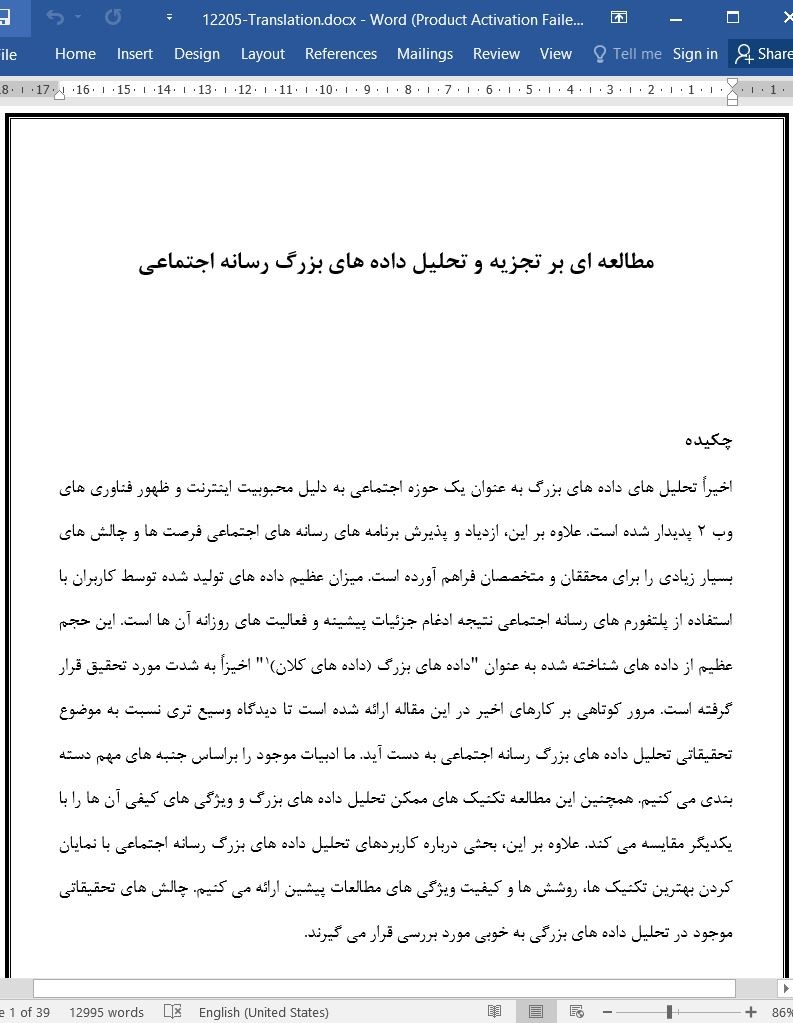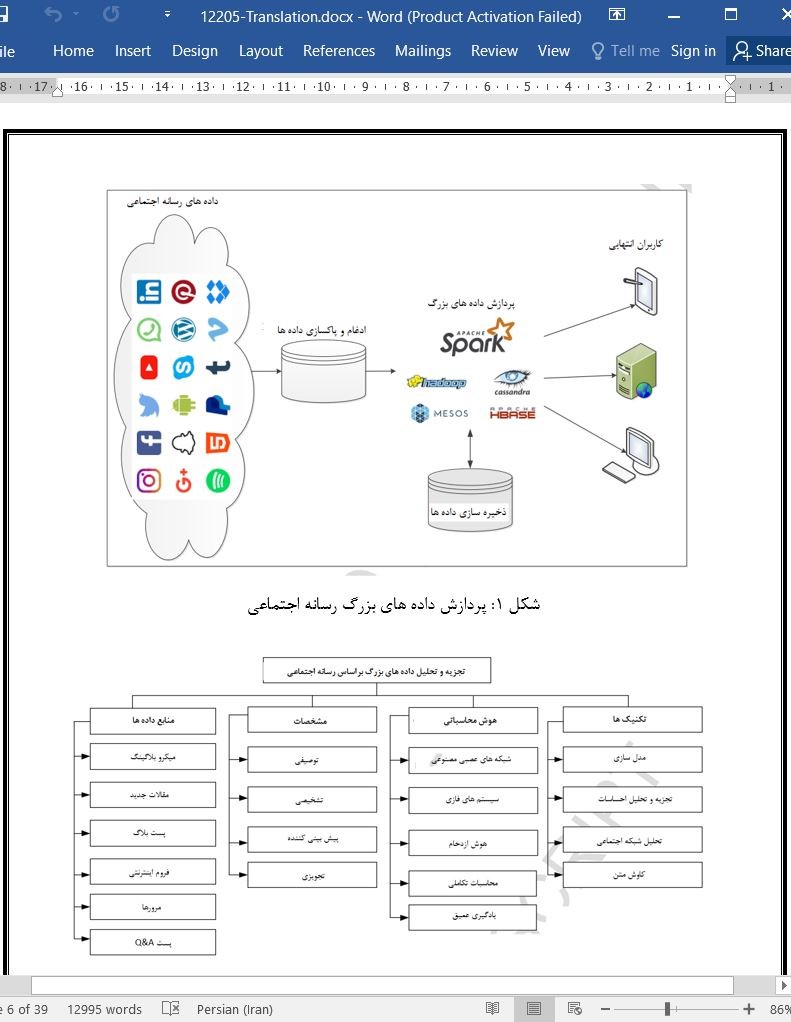
مطالعه ای بر تجزیه و تحلیل داده های بزرگ رسانه اجتماعی
چکیده
اخیراً تحلیل های داده های بزرگ به عنوان یک حوزه اجتماعی به دلیل محبوبیت اینترنت و ظهور فناوری های وب 2 پدیدار شده است. علاوه بر این، ازدیاد و پذیرش برنامه های رسانه های اجتماعی فرصت ها و چالش های بسیار زیادی را برای محققان و متخصصان فراهم آورده است. میزان عظیم داده های تولید شده توسط کاربران با استفاده از پلتفورم های رسانه اجتماعی نتیجه ادغام جزئیات پیشینه و فعالیت های روزانه آن ها است. این حجم عظیم از داده های شناخته شده به عنوان "داده های بزرگ (داده های کلان) " اخیزاً به شدت مورد تحقیق قرار گرفته است. مرور کوتاهی بر کارهای اخیر در این مقاله ارائه شده است تا دیدگاه وسیع تری نسبت به موضوع تحقیقاتی تحلیل داده های بزرگ رسانه اجتماعی به دست آید. ما ادبیات موجود را براساس جنبه های مهم دسته بندی می کنیم. همچنین این مطالعه تکنیک های ممکن تحلیل داده های بزرگ و ویژگی های کیفی آن ها را با یکدیگر مقایسه می کند. علاوه بر این، بحثی درباره کاربردهای تحلیل داده های بزرگ رسانه اجتماعی با نمایان کردن بهترین تکنیک ها، روشش ها و کیفیت ویژگی های مطالعات پیشین ارائه می کنیم. چالش های تحقیقاتی موجود در تحلیل داده های بزرگی به خوبی مورد بررسی قرار می گیرند.
1. مقدمه
محبوبیت اینترنت و ظهور فناوری های وب 2 محتوای وب را از ناشر به محتوای ایجاد شده توسط کاربر تغییر داده است (Alexander, 2006). چنین تغییری در انتشار محتوا بدون نیاز به برنامه ریزی کمک کرده است. امروز موضوعات، مرورها و نظرات جالب مربوط به وب 2 و رسانه اجتماعی به آسانی از طریق اینترنت در سرتاسر جهان در هر لحظه ای قابل دستیابی است. علاوه بر این، ازدیاد و پذیرش رسانه اجتماعی فرصت ها و چالش های گسترده ای را برای محققان و متخصصان فراهم کرده است. بیش از یک میلیارد نفر در سرتاسر جهان در حال استفاده از پلتفورم های رسانه اجتماعی هستند و دادهای ساختار نیافته را در مقیاس های زمانی نسبتاً کوتاه تولید می کنند. حجم عظیمی از داده های تولید شده توسط کاربران نتیجه ادغام جزئیات پیشینه و فعالیت های روزانه آن ها در چنین پلتفورمی است. این حجم عظیم از داده های تولید شده به عنوان "داده های بزرگ" شناخته می شود که اخیراً به شدت مورد بررسی و تحقیق قرار گرفته است.
6. نتیجه گیری
داده های بزرگ رسانه اجتماعی همراه با پیشرفت در ابزارهای محاسباتی، به عنوان کلیدی برای دیدگاه های مهم نسبت به رفتار انسان پدیدار شده است و به طور پیوسته ذخیره و توسط شرکت ها، افراد و دولت ها مورد پردازش قرار می گیرد. اول، ما کار اخیر درباره تجزیه و تحلیل رسانه اجتماعی بزرگ را مورد بررسی قرار می دهیم و چشم انداز وسیعی از این حوزه را اراده می کنیم. دوم، مقالات را براساس جنبه های مهم همانند منابع داده ها، مشخصات، هوش محاسباتی و تکنیک ها دسته بندی می کنیم. سوم، تکنیک های تجزیه و تحلیل داده های بزرگ و ویژگی های کیفی ان ها را با یکدیگر مقایسه می کنیم. چهارم، فرصت ها را با توجه به تجزیه و تحلیل داده های بزرگ براساس رسانه اجتماعی شناسایی می کنیم. در نهایت نیز چالش های تحقیقاتی موجود در تجزیه و تحلیل داده های بزرگ را توصیف می کنیم.
Abstract
Big data analytics has recently emerged as an important research area due to the popularity of the Internet and the advent of the Web 2.0 technologies. Moreover, the proliferation and adoption of social media applications have provided extensive opportunities and challenges for researchers and practitioners. The massive amount of data generated by users using social media platforms is the result of the integration of their background details and daily activities. This enormous volume of generated data known as “big data” has been intensively researched recently. A review of the recent works is presented to obtain a broad perspective of the social media big data analytics research topic. We classify the literature based on important aspects. This study also compares possible big data analytics techniques and their quality attributes. Moreover, we provide a discussion on the applications of social media big data analytics by highlighting the state-of-the-art techniques, methods, and the quality attributes of various studies. Open research challenges in big data analytics are described as well.
1.0 Introduction
The popularity of the Internet and the advent of the Web 2.0 technologies have transformed the contents of the web from publisher- to user-created contents (Alexander, 2006). Such existence has assisted in publishing contents without the needs of programming. Today, interesting topics, reviews, and opinions from Web 2.0 and social media can easily be accessible globally via the Internet in real time. Moreover, the proliferation and adoption of social media have provided extensive opportunities and challenges for researchers and practitioners. More than a billion of people around the world are using social media platforms that generate overwhelming unstructured data in relatively short timescales. The huge amount of data generated by users is the result of the integration of their background details and daily activities in such platform. This massive amount of generated data referred to as “big data” has been intensively researched recently.
6.0 Conclusion
Big social media data along with the progress in computational tools have emerged as the key to crucial insights into human behavior and are continually stored and processed by corporations, individuals, and governments. Frist, we investigate the recent work on big social media analytics and provide a broad perspective of the area. Second, we classify the literature based on important aspects, such as data sources, characteristics, computational intelligence, and techniques. Third, we compare possible big data analytics techniques and their quality attributes. Fourth, we identify the opportunities with respect to big data analytics on social media. Finaly, we describe the open research challenges in big data analytics.
چکیده
1. مقدمه
2. داده های بزرگ رسانه اجتماعی
3. تجزیه و تحلیل داده های بزرگ براساس طبقه بندی رسانه اجتماعی
3-1 منابع داده های رسانه اجتماعی
3-2 مشخصه
3-2-1 تجزیه و تحلیل توصیفی
3-2-2 تجزیه و تحلیل تشخیصی
3-2-3 تجزیه و تحلیل پیش بینی کننده
3-2-4 تجزیه و تحلیل تجویزی
3-3 هوش محاسباتی
3-3-1 شبکه های عصبی مصنوعی
3-3-2 سیستم های فازی
3-3-3 هوش ازدحام
3-3-4 محاسبه تکاملی
3-3-5 یادگیری عمیق
3-4 تکنیک ها
3-4-1 مدل سازی
3-4-2 تحلیل احساسات
3-4-3 تحلیل شبکه اجتماعی
3-4-4 متن یابی (کاوش متن)
4. بحث
5. چالش های تحقیق
6. نتیجه گیری
منابع
Abstract
1. Introduction
2. Big Social Media Data
3. Big Data Analytics on Social Media Classification
3.1 Social media data sources
3.2 Characteristic
3.2.1 Descriptive analytics
3.2.2 Diagnostic analytics
3.2.3 Predictive
3.2.4 Prescriptive analytics
3.3 Computational intelligence
3.3.1 Artificial neural networks
3.3.2 Fuzzy systems
3.3.3 Swarm intelligence
3.3.4 Evolutionary computation
3.3.5 Deep learning
3.4 Techniques
3.4.1 Modeling
3.4.2 Sentiment analysis
3.4.3 Social network analysis (SNA)
3.4.4 Text mining
4. Discussion
5. Research Challenges
6. Conclusion
References
- ترجمه فارسی مقاله با فرمت ورد (word) با قابلیت ویرایش، بدون آرم سایت ای ترجمه
- ترجمه فارسی مقاله با فرمت pdf، بدون آرم سایت ای ترجمه



